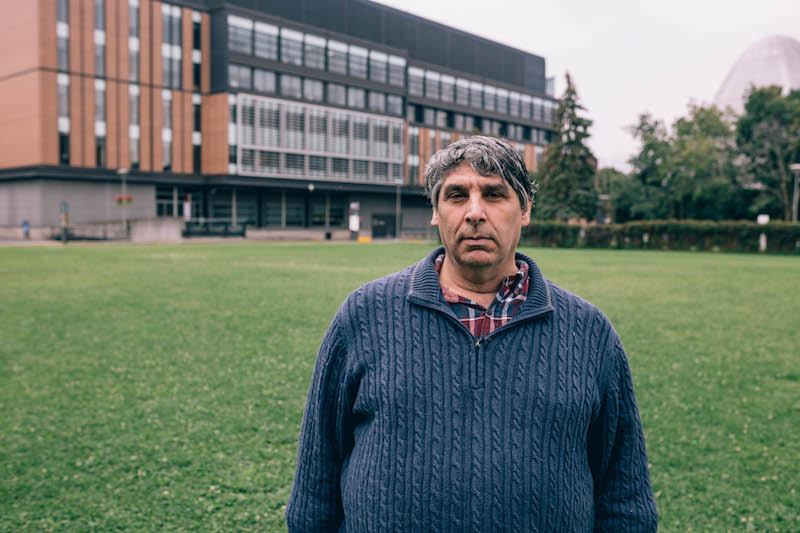Construction on Loyola green space to move ahead despite opposition
N.D.G. resident Irwin Rapoport’s campaign to save the Loyola campus green space was dealt a fatal blow on Monday.
Construction of the new research centre on the green space will now move ahead after Côte-des-Neiges—Notre-Dame-de-Grâce borough officials discovered a clause in Bill 122, a new provincial law adopted in June, which states “public property intended for collective use in the education sector is no longer subject to approval by a referendum.”
Rapoport and other N.D.G. residents had hoped to preserve the green space. “The residents are seeking a moratorium on any development of green space on the campus,” Rapoport told The Concordian early last week. A group of residents wanted to have the development moved to one of the nearby parking lots, with an underground parking garage built to replace the current lot.
Following a borough council meeting on Monday night, Rapoport called the legislation “an attack on democracy.” He criticized the borough for its oversight. “You didn’t cross the t’s and dot the i’s on this one,” he said.
C.D.N.—N.D.G. Mayor Russell Copeman said the city is just respecting the rule of law. “I was as startled as the next person about this [discovery],” he said. “But we’ve double-checked everywhere, and we really feel that, by our legal department, we have no option but to reject the petition. It would be illegal to hold a register under these conditions.”
With the threat of a referendum off the table, Concordia can move forward with its plan to begin construction of the $52-million research centre this spring. The building, which will house research centres for nanoscience and cell biology, will occupy 15 per cent of the nearly 8,800 square metre field behind the Richard J. Renaud Science building.
Rapoport said he is concerned the research centre may only be the beginning of development on the green space. At an C.D.N.—N.D.G. urban planning committee meeting on Aug. 7, he confronted a Concordia official about whether or not further developments would follow. “I asked him: ‘Would you guarantee that the remainder of the field would not be developed?’ He couldn’t say no. He couldn’t say yes or no.”
University spokesperson Mary-Jo Barr said Concordia has no plans to develop the green space beyond the current project. Furthermore, “any future development would need to be approved by the borough and would involve public consultation,” she said.
Even moving the development would not solve all of the community’s concerns. Lisa Kagan lives adjacent to the green space, and said she is worried about noise pollution from the construction and the building’s ventilators. She also worries the building’s presence will create more traffic on her street, which borders the space.
“Already, I have to deal with a lot of Concordia students on my quiet street hopping my fence, and parking and traffic.” She said students often block her neighbours’ driveways with their cars. In addition, she said, before Concordia security stepped in, she would catch a student hopping her fence “at least once a week.”
Rapoport had originally petitioned the city to open a register on the project, gaining 95 signatures of the necessary 12 before the clause in Bill 122 was discovered.
Rapoport said he will continue to fight this project. “We’re going to have to appeal to a higher level of the opposition of Montreal.”
“This green space is more than just Concordia’s green space—it’s become a de facto public green space,” Rapoport said.
Concordia student Gabi Mandl disagrees. “I am so thankful that Mayor Copeman and the council unanimously approved the project because they clearly understand how valuable it is,” the chemistry graduate student said. “This isn’t a building being constructed for business or profit. It is for students to be able to learn and flourish.”

Mandl said she hopes to pursue her PhD at Concordia once the new centre is built. She said the community’s demands are unreasonable and unrealistic. “I don’t think it’s a good use of funding to build [an underground] parking lot when all they have to do is build a building next to a parking lot on a huge, unused plot of grass,” she said.
Some residents had previously proposed moving the building either to the parking lot across campus next to the physical services building or the one next to the green space behind the St-Ignatius of Loyola Church. Mandl said the first option would place the new building too far away from the existing science building for the two to be connected by a tunnel. Such a tunnel is necessary to protect the student body from exposure to dangerous substances, including nanoparticles and cell cultures.
The tunnel is also necessary to protect samples from contamination and exposure to the elements. Biochemistry undergraduate student Tommy Roumanas said the human cells Concordia uses for research must be kept safe while in transport. “Human cells are very, very delicate,” he said. “As soon as we take them out of that 37 C incubator, we’re on a timer.” Furthermore, contamination of these cells can go unnoticed for months.
As for the parking lot next to the green space, which is close to the science building, Mandl said she worries about the cost of replacing this lot with underground parking. According to one study, underground parking garages cost on average about $41,600 per space. At this rate, replacing the roughly 80 existing parking spaces would cost more than $3.3 million. Furthermore, Barr said the university does not have permission to build on the suggested parking lot.
According to Barr, a website is in the works to keep the public informed on the project. “Our neighbours are important to us,” she said. “They have always been welcome on our campuses. We aim to create a campus that is an asset for all.”




